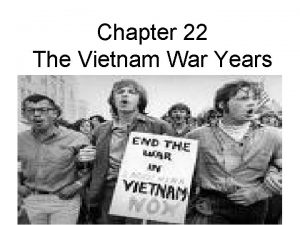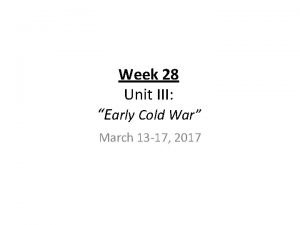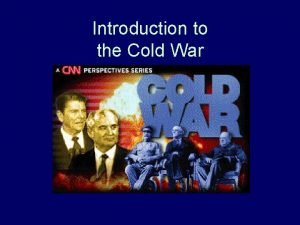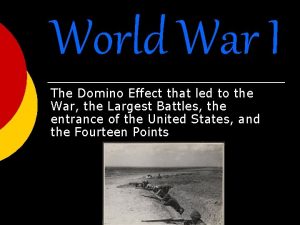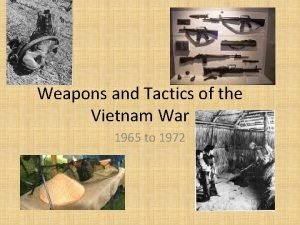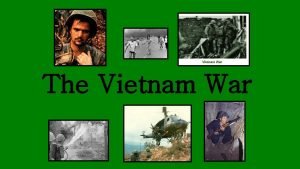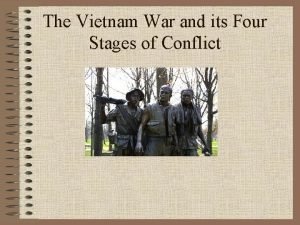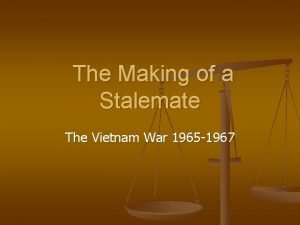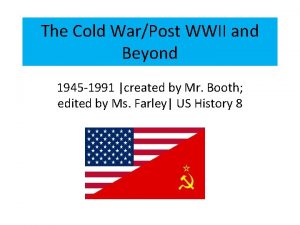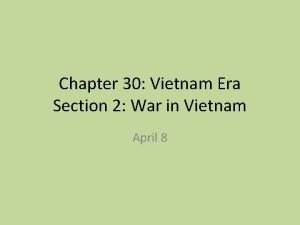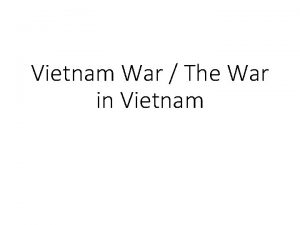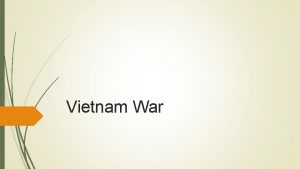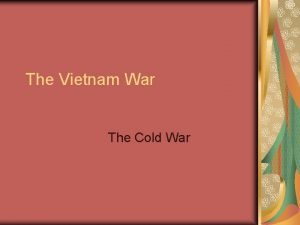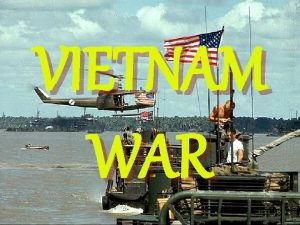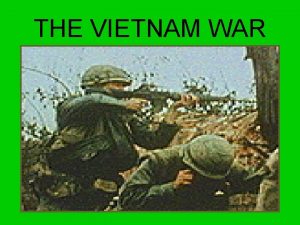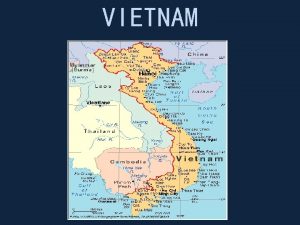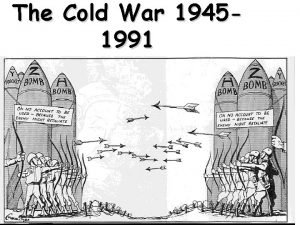Conclusion of the Cold War Vietnam War Domino













- Slides: 13

Conclusion of the Cold War

Vietnam War • Domino Theory – if Communism was successful in Vietnam, it would spread throughout Asia other countries would fall like “dominoes” • Vietnam had been a French colony – post WWII Vietnam gains independence in a war with France (1950 s) • Vietnam split into North (communist) and South Vietnam, elections to be held for a united country but U. S. doesn’t want this (feared communist victory) • North Vietnam led by Ho Chi Minh • Presidents Eisenhower & Kennedy send aid to the south and train Vietnamese troops, but Minh’s Viet Cong (guerilla soldiers) are taking over large chunks of the south so the U. S. gets directly involved.

• Soviets & Chinese supply the North with weapons & supplies, but do not send their own troops. PROXY WAR • Throughout the 1960 s the Vietcong uses guerilla warfare to great effect, staging ambushes and surprise attacks and hiding in the dense jungle. • Americans use a chemical called Agent Orange to get rid of jungle cover and to destroy crops, this chemical causes birth defects and cancer. (some 12, 000 gallons of Agent Orange are sprayed over S. E. Asia by the USA. ) • Because of the guerilla tactics, it was essential to “win the hearts and minds” of the Vietnamese people so that villagers/peasants would help the American troops and not the Vietcong. This was made impossible by U. S. tactics including the widespread use of napalm.


Vietnamese children flee after their village has a napalm bomb dropped on it, the village was a suspected Vietcong stronghold.

• The U. S. attacked many civilian targets to try and force the North to surrender. • U. S. also committed a number of serious war crimes such as the My Lai massacre – around 400 Vietnamese civilians are raped, tortured, and murdered. • Massive protests against the Vietnam war occur in the U. S. – public opinion from the mid-60 s onward declines greatly. • 1973 – U. S. forced to withdraw after trying to train South Vietnamese soldiers to continue the war. • Vietnam is a failure for the U. S. policy of containment as laid out in the Truman Doctrine.

Bodies from the My Lai massacre committed by U. S. troops

Impact of Vietnam War • Vietnam is regarded as the greatest U. S. military defeat/blunder in history • incredible loss of international prestige for the Americans • Example of “liberal democratic” government committing illiberal acts (attacking civilians, war crimes, use of Agent Orange) • Vietnam is still a communist country today.

• Czechoslovakia (1968): a. k. a. Prague Spring – Spring: local communist officials begin to introduce reforms allowing more freedom – August: Soviets invade, Czechs used passive resistance rather than fighting – learned lesson from Hungarian uprising – Units of the Red Army permanently stationed in Czech. until 1990

• USSR invades Afghanistan (1979): – ANOTHER PROXY WAR – Soviets invade to support a Communist gov’t – Americans supply Islamic Mujahedeen rebels with weapons and supplies – Communists were defeated and the Taliban gov’t eventually comes to power in Afghanistan, puts in place strict sharia law – Example of “liberal democratic” gov’t following foreign policy that leads to actions that contradict liberalism and respect for human rights

Détente • Détente refers to both the time period and the behaviour of reduced tensions between the superpowers. (mid 1960 s-1979) • Increased use of diplomacy – peaceful negotiations and meetings between USA & USSR • SALT – Strategic Arms Limitation Treaties – limit # of missiles for each country. • NPT – Non-proliferation Treaty – limits the spread of nuclear weapons, no nukes for countries that don’t already have them. • Reduction in arms spending and build-up of nuclear weapons

• Soviet invasion of Afghanistan and policies of President Reagan in 80 s increase tensions again for a bit (Reagan increased military spending dramatically). • Mid-1980 s – Mikhail Gorbachev becomes Soviet leader and attempts to “open up” the Soviet system – – Less political and economic control by gov’t Some private business allowed Some freedom of speech and democratic rights allowed Reduces emphasis on expanding Soviet sphere of influence

• Gorbachev’s reforms introduced some freedom to the USSR and other Soviet-controlled countries in Eastern Europe for the first time in 50+ years this led to increased protests and pressure being placed on communist gov’ts. • Fall of Berlin Wall (1989) – pro-democracy movements spread across Eastern Europe, East Germany’s communist leaders forced from power and the Wall is torn down. Germany reunited as one liberal democratic country • 1990 -91 – Collapse of Soviet Union – splits into many independent countries (Russia is largest), many of which are unstable, but Cold War is finally OVER.
 The domino theory vietnam war
The domino theory vietnam war Lesson 1 the cold war begins
Lesson 1 the cold war begins Description
Description Presidential and congressional reconstruction venn diagram
Presidential and congressional reconstruction venn diagram Cold war sides
Cold war sides United nations flag
United nations flag Conclusion of foreign policy
Conclusion of foreign policy What was the domino effect in ww1
What was the domino effect in ww1 Us weapons vietnam war
Us weapons vietnam war Results of vietnam war
Results of vietnam war Vietnam war stages
Vietnam war stages Did the vietnam war end in a stalemate
Did the vietnam war end in a stalemate Vietnam war at home webquest answers
Vietnam war at home webquest answers Vietnam war causes
Vietnam war causes
